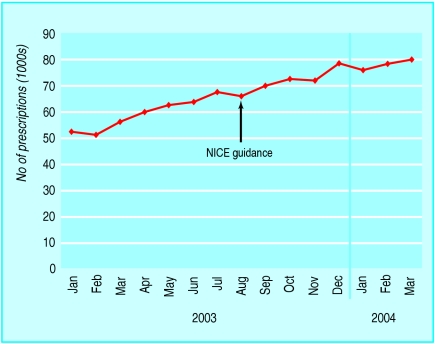Editor—Sheldon et al investigated whether guidance from the National Institute for Clinical Excellence (NICE) has been implemented.1 We found a lack of implementation of newer guidance.
We examined how NICE guidance, published in August 2003, altered prescription rates of glitazones for type 2 diabetes mellitus. NICE recommended that glitazones be used as a second line treatment in combination with either metformin or a sulphonylurea in patients with type 2 diabetes who cannot tolerate metformin and sulphonylurea in combination and for whom these drugs are contraindicated.2 We postulated that prescription of glitazones would increase on the basis of the advice, since the guidance resulted in a concise framework for the management of type 2 diabetes.2
The figure shows the numbers of glitazone prescriptions nationally. We applied an ARIMA (auto regressive integrated moving average) model to the data, which led to no notable changes in prescribing rates as a result of NICE guidance. P values were 0.40, 0.97, and 0.40 for total prescriptions, pioglitazone, and rosiglitazone, respectively.
Figure 1.
Numbers of prescriptions of glitazone, January 2003 to March 2004, before and after NICE guidance (ePACT; electronic Prescribing Analysis and Costs)
This absence of difference may be because the impact is slow and falls outside the data capture period; the intervention may have reduced a bigger change; the “before and after” method is too crude to detect changes of this type; or our research was underpowered to detect such changes.
However, our results are another indication that NICE guidance does not affect clinical practice. NICE's premise is commendable, standardising treatments across the health service and promoting evidence based health care, but implementing guidance into clinical practice is another challenge. How the recently assigned “board level implementation executive” will take on this mammoth task will be interesting.3
The data were compiled by the Statistical Division, Department of Health.
Competing interests: None declared.
References
- 1.Sheldon TA, Cullum N, Dawson D, Lankshear A, Lowson K, Watt I, et al. What's the evidence that NICE guidance has been implemented? Results from a national evaluation using time series analysis, audit of patients' notes, and interviews [with commentary by N Freemantle]. BMJ 2004;329: 999-1004. [DOI] [PMC free article] [PubMed] [Google Scholar]
- 2.National Institute for Clinical Excellence. Guidance on the use of glitazones for the treatment of type 2 diabetes. Technology appraisal guidance No21. London: NICE, 2003.
- 3.National Institute for Clinical Excellence, Special Health Authority. Supporting implementation of NICE guidelines. London: NICE, 2004. www.nice.org.uk/Pdf/boardmeeting/brdmay04item4.pdf (accessed 22 Apr 2005).



